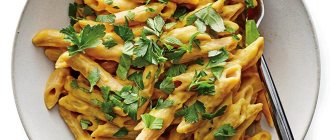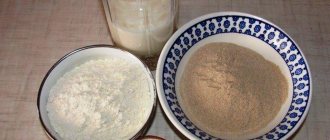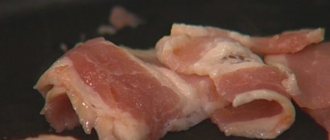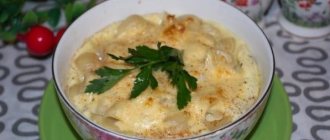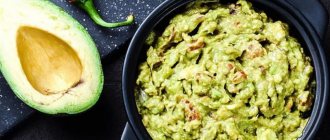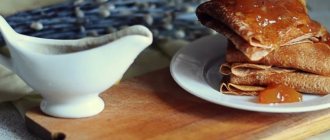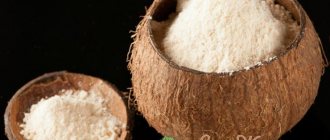Buckwheat pasta
This type of pasta came to us from South Korea, where buckwheat and wheat flour are most often used in preparation. However, there is another recipe, the ingredients of which are only buckwheat flour and water. Both types of pasta are remarkable, healthy and interesting in their own way.
Most often, these pasta are brown in color and when cooked they emit the aroma of buckwheat porridge. The taste is reminiscent of something between your favorite buckwheat and traditional pasta made from wheat flour.
In a word, no gourmet can resist!
What are the benefits of buckwheat pasta?
The composition of buckwheat pasta is very interesting:
- Minerals – potassium, magnesium, phosphorus, iron, calcium;
- Vitamins of group B and PP;
- Proteins;
- Carbohydrates.
All these elements determine the valuable properties of buckwheat pasta. They:
- good for blood. Because they accelerate blood circulation, increase hemoglobin levels and promote the formation of new cells;
- help in the treatment of diseases of the heart, blood vessels and gastrointestinal tract;
- normalize metabolism;
- have a beneficial effect on the nervous system.
As you can see, buckwheat pasta deserves your attention as a consumer.
Moreover, you can cook many delicious dishes with them. Let's look at an example.
Vegetable stew with buckwheat pasta: recipe
This dish is perfect for both a simple home dinner and a holiday table. Undoubtedly, your guests will enjoy the pleasant taste and original appearance of unusual pasta.
Ingredients:
- buckwheat noodles – 100 gr.;
- red onion – 1 pc.;
- carrots – 1 pc.;
- eggplant – 1 pc.;
- broccoli - several whisks;
- olive oil;
- preferred herbs (basil, dill);
- any seasonings.
Preparation:
All vegetables must be peeled, chopped and fried in olive oil for 7-10 minutes. Next, add hot water to the stew and simmer, gradually adding salt and spices. In 8-10 minutes, you need to add buckwheat curly pasta and finely chopped greens to the dish. You can leave a little fresh dill to garnish the finished dish.
Next, the stew must be stirred thoroughly until the water has completely evaporated. Undoubtedly, when preparing it, you will be enchanted by the magical aroma of this stew. And your household will ask you to cook this delicious dish more than once.
And now, dear readers, the site offers to discuss another type of healthy pasta - corn pasta.
Believe me, they also deserve your attention.
Calorie content
Calorie content in its pure form (i.e., those products that have not been subjected to heat treatment) varies from 300 to 400 kcal per 100 grams. You can find the composition and KBJU (calories, proteins, fats, carbohydrates) on the product packaging itself.
When cooking, the calorie content does not change, but remember that calories are counted by the dry weight of the product, and not by the finished weight. That is, first you need to weigh a certain amount of pasta that you want to cook and “drive” it into your calorie counter. It is then that the figure will be correct, because when cooked, pasta tends to boil over and becomes heavier, which accordingly changes its weight.
The calorie content of pasta depends on its type and manufacturer. For example, buckwheat pasta will have about 370 kcal per 100 g, but regular, whole grain pasta can have either 333 kcal/100 g (Naturata pasta) or 360 kcal/100 g (JamieOliver).
For example, let’s imagine some types of ready-made pasta with and without additives:
| Product | Calorie content per 100 g |
| Pasta boiled from durum wheat | 112 kcal |
| Boiled pasta with butter | 135 kcal |
| Boiled buckwheat pasta | 139 kcal |
| Boiled pasta with mushrooms | 174 kcal |
| Boiled macaroni with cheese | 224 kcal |
The calorie content of a dish directly depends on the ingredients you use for cooking. To more or less accurately determine the energy value of your dish, it is best to count all the ingredients separately.
Corn pasta
As you might guess, this pasta is made from cornmeal and water. Outwardly, they are very similar to their wheat counterparts. But you can identify corn pasta at first glance by its bright yellow hue, reminiscent of corn.
The taste of this pasta is also similar to wheat products. However, if you taste it, there is a lighter and more pleasant corn note in the pasta.
Corn pasta: benefits
Corn pasta contains a lot of:
- mineral salts;
- calcium;
- phosphorus;
- β-carotene;
- vitamins A and C.
Thanks to these elements:
- vitality increases;
- metabolism is normalized;
- accumulated toxins are removed from the body;
- the cardiovascular system is strengthened;
- the functioning of the gastrointestinal tract is normalized.
An important difference between corn pasta is its dietary properties. Therefore, people suffering from various diseases of the stomach, intestines and blood are recommended to regularly eat pasta made from corn flour.
Corn pasta: how to cook?
Like buckwheat pasta, the recipe for which is described above, corn pasta goes well with vegetables.
Just don't add them to soups or other first courses because they spread very quickly.
The best option is to stew pasta with different vegetables.
Don't be afraid to experiment! The more often you show your imagination, the richer your diet and culinary experience will become.
For example, let's make a salad of vegetables and corn pasta.
Ingredients:
- pasta – 200 gr.;
- fresh champignons – 200 gr.;
- carrots – 1 pc.;
- fresh cucumber – 1 pc.;
- red onion – 1 pc.;
- dill, cilantro, celery;
- vegetable oil;
- mayonnaise.
Preparation:
First you need to boil the pasta.
Important! You can boil corn pasta only in a wide bowl and with constant stirring. Exactly 10 minutes.
Cucumber and greens need to be chopped, mixed with prepared pasta, vegetables, mushrooms and seasoned with mayonnaise.
Excellent salad is ready! Bon appetit!
So, in this article we looked at corn and buckwheat pasta. Of course, the world of pasta is not limited to this. On the website “Beautiful and Successful” you can also find out why they are useful and how to prepare them.
Healthy corn and buckwheat pasta, recipes with them you will definitely like and come in handy. Especially if you alternate between preparing different types of products.
Be healthy and charming!
- Japanese noodles made from buckwheat flour. It is considered a dietary option, which is much healthier than analogues made from premium white flour, which in our country are consumed by the entire population.
Culinary recipes
Below are several dishes whose main ingredient is pasta. These dishes are easy to prepare, low in calories, but will bring great benefits to your body!
Pasta with chicken and broccoli
Ingredients:
- chicken fillet – 800 g;
- olive oil – 1 tbsp. spoon;
- broccoli florets – 2 cups;
- pasta – 1 package (400-500 g);
- finely chopped onion - half a glass;
- salt, spices - to taste.
Preparation:
Heat a frying pan over medium heat, add olive oil. Cut the chicken fillet into small cubes and fry in a frying pan until golden brown. Add onion and pre-boiled broccoli to the fillet. Add a little water and simmer everything until the onion acquires a darker (golden) color.
While the vegetables and chicken are stewing, pour water into a saucepan, bring to a boil, add the pasta and cook until tender (8-10 minutes). After which you can lay out the pasta and add chicken and vegetables there. Use salt and seasoning to taste.
Creamy macaroni and cheese
Ingredients:
- pasta – 1 package (400-500 g);
- grated hard cheese – 100-150 g;
- cream 10% - 100 ml;
- salt and spices to taste.
Preparation:
Following package instructions, cook pasta until done. Heat the cream in a small, shallow saucepan and add the grated cheese. Season with spices. Stir slowly and remove pan from heat when cheese begins to melt.
Drain the pasta in a colander, transfer it to a plate, and top with cheese and cream sauce. The dish can be decorated with finely chopped herbs.

Fettuccine with seafood and tomatoes
Ingredients:
- fettuccine (thick noodles) – 400-500 g (1 pack);
- olive oil – 2-3 tbsp. spoons;
- sea cocktail – 100-150 g;
- tomatoes – 5-6 small pieces;
- onion – half a whole or 1 small;
- greens (dill, parsley);
- salt;
- spices.
Preparation:
Place a saucepan of salted water over low heat, add the fettuccine and cook until tender, following the instructions on the package.
Add olive oil to a hot frying pan, finely chop the onion and fry until golden brown. Then finely chop the tomatoes, simmer them a little with onions and add the sea cocktail. Stirring constantly, simmer for 3-5 minutes. Place a mixture of tomatoes and seafood on the finished pasta, sprinkle with herbs and seasonings on top.
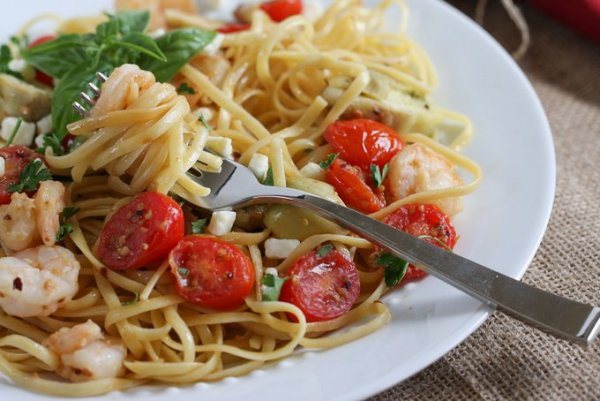
Pasta with green beans
Ingredients:
- pasta – 400-500 g (1 package);
- green beans –250-300 gr;
- tomatoes – 2 pcs.;
- garlic – 2 cloves
- olive oil – 2 tbsp. spoons;
- tomato paste – 2 tbsp. spoons;
- salt;
- ground black/red pepper.
Preparation:
In a saucepan of salted water, cook the pasta until tender, following the instructions on the package. Peel the tomatoes, cut into squares along with the garlic and simmer with olive oil over low heat for 3 minutes. Add frozen beans to tomatoes and simmer until tender. At the end, add tomato paste and seasonings and mix. Place the pasta on a plate, add beans and tomatoes on top. You can season it with soy sauce.
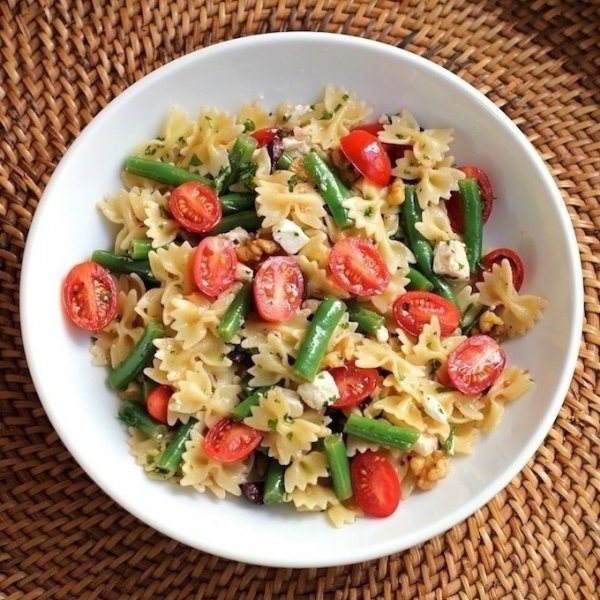
Culinary traditions of East and West
The population of Asia eats mainly healthy foods that not only saturate the body with calories, but also with nutrients. They practice moderation in food. That is, it means that you need to eat in accordance with the needs of the body. Only ill-mannered people in Asia will eat a lot.
In Japan, the population eats a balanced diet. Their usual diet will greatly surprise residents of our country. Today, their food products have become popular in our latitudes, including buckwheat pasta. Buckwheat noodles can be recognized by their brown tint. It is cut into long flat strips. You can also find spaghetti, in which buckwheat flour predominates.
Features of buckwheat noodles
But not all dark-colored pasta is made from buckwheat flour. There may be bran and/or rye flour. Buckwheat noodles are called soba in Japan. The best is considered to be the one made by hand from flour with the addition of water.
It contains a lot of vitamins and minerals. This is the leader in usefulness among all kinds of pasta. Buckwheat is considered one of the healthiest grains; accordingly, flour made from buckwheat is also healthy. During flour production, the amount of nutrients remains the same. The leaders in the composition are vitamins B1 and B2.
Calorie content
buckwheat noodles: 348 Kcal. It seems like a lot. But in fact, this is a filling product, so you won’t eat much of it. In addition, noodles made from buckwheat flour are digested slowly. These are complex (or slow) carbohydrates, unlike noodles and other white flour pastas. It also contains highly digestible natural proteins.
Makfa buckwheat pasta - calorie content, beneficial properties, benefits and harm, description
Calories, kcal:
350
Carbohydrates, g:
70.9
The birthplace of buckwheat pasta is Japan. This type of pasta is made from buckwheat and wheat flour and water. There are also pastas that contain only buckwheat flour and water. Both buckwheat pasta have a characteristic brown tint. During cooking, the product emits the smell of boiled buckwheat, and the taste resembles a mixture of traditional pasta and buckwheat. Buckwheat pasta is considered a dietary option and is healthier than a similar product made from white flour.
Calorie content of buckwheat pasta Makfa
100 grams of Makfa dry buckwheat pasta contains 350 kcal.
Composition of Makfa buckwheat pasta
Buckwheat pasta Makfa consists of durum wheat flour (second grade), buckwheat flour and drinking water. May contain traces of egg products. The manufacturer claims that the product does not contain GMOs, dyes or food additives.
The benefits and harms of Makfa buckwheat pasta
Buckwheat pasta Makfa combines the advantages of durum wheat and buckwheat. The product contains dietary fiber, which are so-called natural prebiotics - the main food for intestinal microflora. They help restore metabolism and stimulate intestinal function, providing natural cleansing of the body. In addition, dietary fiber slows down the absorption of sugar after eating food, which is beneficial for diabetics.
Also, eating this product helps improve blood circulation and increases hemoglobin levels. Buckwheat pasta has a beneficial effect on the functioning of the heart, gastrointestinal tract and has a beneficial effect on the nervous system. The product contains vitamins B1, B2, B6, B9, E, PP and a number of microelements necessary for the body.
Harm from buckwheat pasta can be caused to persons with individual intolerance or allergies. In addition, eating such pasta with mayonnaise salads, fried and fatty foods can cause excess weight.
Buckwheat pasta Makfa for weight loss
Due to the fact that buckwheat flour and durum wheat flour are used to prepare Makfa buckwheat pasta, the product contains a large amount of complex carbohydrates. Such carbohydrates are absorbed by the body slowly, which helps maintain a feeling of fullness for a long time and avoid snacking. The product contains a minimum of fat and a sufficient amount of protein. Buckwheat pasta is also rich in fiber, which not only helps cleanse the body of toxins, but also promotes the normal functioning of the digestive system.
Buckwheat pasta in cooking
Buckwheat pasta is a universal product that can be eaten both hot and cold. They are easy to prepare and can be eaten as a side dish or as a main dish. The product goes well with vegetable salads, seafood, meat dishes and a variety of sauces. Buckwheat pasta is also great for making soups and salads.
www.calorizator.ru
Effect on the body
Buckwheat noodles can and should be eaten by those who know first-hand about the problems of excess weight, especially people diagnosed with obesity. It contains rutin, which is considered a strong oxidizing agent and is beneficial for capillaries.
Studies have proven that the presence of buckwheat noodles (which do not contain white flour) in the diet reduces cholesterol levels and stabilizes blood pressure in people. The substances that are present in such noodles have a positive effect on digestive processes and can speed up metabolism. This point also needs to be taken into account by overweight people, because their metabolism is generally inhibited, which provokes the deposition of fat.
Energy value and composition
100 grams of raw buckwheat noodles contain 14.7 grams of protein, which is about 59 kcal. Fat 0.85 grams, which corresponds to 8 kcal. It contains 70.5 grams of carbohydrates, which corresponds to 282 kcal. But in the store you can find different types of noodles that differ in composition. Accordingly, calorie content and dietary fat may also be different. Take this into account when planning your diet.
Compound
As you can understand from the above data, buckwheat noodles are not greasy. Therefore, it is digested quite quickly. It contains the following useful substances:
- vitamin B1
- calcium
- potassium
- magnesium
- selenium
- manganese
- sodium
- phosphorus
- iron
How to use
Soba noodles are a versatile food that can be eaten at any time of the year. Noodles made from buckwheat flour are consumed hot or cold. It can be served as a side dish or as a main course. It is put in soups and salads.
Cooking methods: baking, boiling, frying. You can add sauce. This will make the dish more appetizing, but will significantly increase the calorie content of the dish. Of course, you can make the sauce at home to know exactly its composition and usefulness.
Most often, soba is served without broth, chilled, along with sauce on a special dish. A little less often, buckwheat noodles are served as soup (along with heated broth).
The influence of cooking method on calorie content
The calorie content of cooked pasta changes during cooking. This is influenced by the amount of water and what additives you use to add flavor and aroma to the dish. But there are also other nuances - be sure to look at the calorie content of the paste on its packaging, because depending on the brand and composition, the energy value can vary significantly.
Often, without thinking, we put something into ready-made pasta for taste and smell, for example, salt, soy sauce, seasonings, sauces, sour cream, butter, etc., without thinking about how much they increase the calorie content of the entire dish. For many this is not a problem, but there are those who watch their diet very strictly or adhere to a certain diet. That is why you should carefully monitor what and in what quantity you add to the prepared product. This is especially true for additives such as cheese or meat, because they are quite fatty and high in calories.
Find out the calorie content of pasta with butter in this article
We will tell you about the calorie content of scrambled eggs on our website.
How many calories are in your favorite borscht - with chicken, beef or pork - you will learn from the article here https://hudelkin.ru/produkty/kalorijnost-borshha-kuricej-svininoj.html

